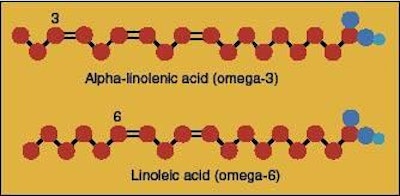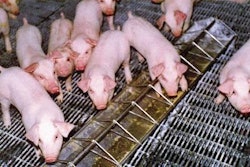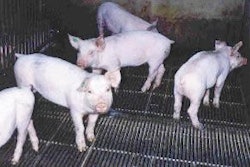
Producing animal products rich in omega-3 fatty acids is one of the latest approaches to improving the marketability of eggs, red meat and now pork. The intention, of course, is to capture the increased consumer interest in the health-promoting properties of foods. The latest food-store surveys continue to indicate that the fastest growing grocery brands are those that claim health benefits.
Human nutritionists say future emphasis should be on improving the fat quality in our diet and that translates into less saturates and more omega-3 fatty acids. A UK scientific advisory committee on nutrition has recommended that we double our consumption of the very long chain omega-3 from 0.1 to 0.2g/day. Some foods with this content are even permitted by law to make the claim that they benefit heart health, particularly in those who have already suffered from heart disease.
Omega-3 polyunsaturated fatty acids are also important in the development of brain tissue and healthy membranes besides having important anti-inflammatory benefits. The ‘3' in their name refers to the place on the molecule where the first unsaturated double bond is found (see Figure 1). Good sources of the very long (20 carbon chain and longer) omega-3s are fish oil and oily fish, although rapeseed and flax (linseed) provide long chain (18 carbon) omega-3. Most polyunsatures in the diet of both man and livestock are omega-6, largely provided by oilseeds, such as soya and sunflower. The ratio of omega-6 to omega-3 in a typical human diet is between 5.0-7.0:1, but the desirable range is 3.5- 4.0:1.
Although fish may be the richest source of omega-3, some people simply do not eat fish. For them, omega-3 rich animal products are essential. In many cases the consumption of a single omega-3 rich egg would be enough to overcome the daily deficit. On average, animal products contribute around 15% of the daily intake of the very long chain omega-3s, but with enriched animal products this contribution could double.
The omega-3 rich products already on the market usually are produced by special feeding of the animals or birds. But research from the US is pointing to a novel way forward. A team of scientists from Harvard University, the University of Missouri and the University of Pittsburgh took a gene from an ocean roundworm which naturally converts omega-6 into omega-3 and simply transferred it into a pig cell.
The researchers began by harvesting over 1600 eggs from female pigs. They removed the genetic material from the eggs and replaced it with new DNA that had the roundworm gene inserted. The manipulated embryos were then implanted into 14 surrogate mothers. A total of 10 male piglets were born. DNA analysis of the piglets showed that 6 had the earthworm gene. According to Jing Kang from Harvard University, the cloned pigs produced one-fifth the amount of omega-3 fatty acids found in salmon. But successive generations conventionally bred could enhance the efficiency of the gene and produce higher amounts of omega-3.
Although the technology looks exciting, getting the pigs to market is likely to be some time away neither US nor EU regulators allow genetically altered animals to enter the food chain, despite scientific studies showing food from the animals is safe.
In the meantime, we can still focus on increasing the omega-3 content of pork by manipulating the pig's diet. Analysis¹ of published results shows that, under the best conditions, feeding animals with extracts of linseed and rapeseed or fishmeal or fish oil can increase the level of omega-3 by 20- to 40-fold in eggs, 10-fold in chicken, 6-fold in pork and less than 2-fold in beef. Concerns about the effect of dietary omega-3s on the eating quality of pigmeat seem to be largely unjustified at the levels likely to be used in commercial practice. A project at the University of Bristol in the UK added 60 grams of whole linseed per kilogram of feed given to growing pigs. The resulting pork was rated as having good eating quality, increased levels of omega-3s and an improved ratio of polyunsatured to satured fatty acids in all tissues.

















